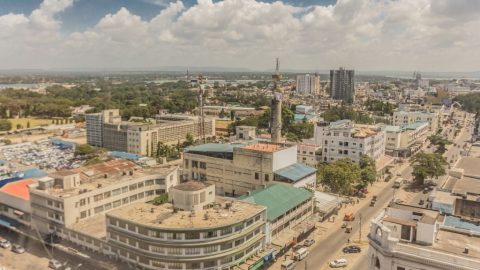(CNN) — The only surviving prototype of this unusual plane now sits dilapidated in a field near Moscow, but it was once the hope of the Soviet Union against US submarine attacks.
The Bartini Beriev VVA-14 — the letters are an acronym for “vertical take-off amphibious aircraft” and 14 was the number of engines — was designed to take off from anywhere without a runway and to be capable of sustained flight just above the water surface.
Designed in the 1960s, the aircraft was a response to the Polaris ballistic missiles. The United States introduced them in 1961 on its submarine fleet as part of its nuclear deterrent. In the mind of its designer, Robert Bartini, the amphibious VVA-14 would be the perfect machine to seek and destroy the missile-carrying submarines.
The plan, however, didn’t pan out. Only two of the proposed three prototypes were ever built, and only one was ever flown. When Bartini died, in 1974, the project died with him, and the second prototype was dismantled.
The first, mostly intact, was sent in 1987 to the Central Air Force Museum near Moscow, but something went wrong with the delivery. The aircraft was looted and damaged, and it hasn’t been repaired since.
Three-headed dragon
“The VVA-14 was a flying boat that was supposed to take off from water or land vertically, and then fly like a regular plane at altitude,” says Andrii Sovenko, a Soviet aviation historian. In 2005, Sovenko met Nikolai Pogorelov, the deputy of Robert Bartini during the design phase of the plane.
“According to Pogorelov, Bartini was a visionary who had an unusual mind and character. It seemed that he was not from his time, but from some other era — someone even called him an alien. Without a doubt, Bartini has left a mark in Soviet aircraft building. However, he became famous mainly for his ideas and concepts, and only a few of those actually became reality,” says Sovenko.
Bartini, who left his home in Italy for the Soviet Union in 1923 after the rise of the Fascists, had envisaged several different versions of the VVA-14, including one with inflatable pontoons to land on water and another with folding wings that could be operated from ships at sea.
The first prototype took to the air in 1972. It was later fitted with the pontoons and tested afloat.
“This aircraft did not have lifting engines or any equipment for searching for submarines. It was intended only for studying the characteristics of horizontal flight and testing the aircraft systems. In total, from 1972 to 1975, it performed 107 flights with over 103 flight hours,” says Sovenko.
The odd looks earned it the nickname Zmei Gorynich, after a dragon from Russian folk tales. “When looking at it from the ground, the VVA-14 caused understandable associations with Zmei Gorynych: she also had, as it were, three heads, as well as relatively small wings,” said Sovenko.
A short second life

The Soviet military abandoned the project after they realized its effectiveness would be limited.
Courtesy Andrii Salnikov
The second prototype was supposed to receive the engines for vertical take off, but they were never fitted to the almost completed plane, because a suitable engine type was never developed. This doomed the project, and the aircraft was disassembled.
Bartini tried to pump new life into the VVA-14 by turning into an ekranoplan, a type of aircraft that uses ground effect to glide close to a surface like water at high speed like a hovercraft does. The resulting tests, performed just after Bartini’s death, informed the development of other such aircraft, making the USSR the undisputed leader in the field.
Despite this coda, however, the project was out of steam.
“I think the Soviet military very quickly realized that the effectiveness of the VVA-14 as an anti-submarine aircraft would have been low. It could only carry a very small number of missiles and the technical challenges of creating such an unusual vehicle were very large. Ultimately, the military relied on more conventional aircraft for the job,” says Sovenko.
After it was retired, the original prototype was transferred by barge from Taganrog in southern Russia, where it had been built and tested, to a small town near Moscow, Lytkarino. Unloaded ashore, it was left unattended and partially destroyed and dismantled.
Later transported via helicopter to nearby Monino at the Central Air Force Museum, the aircraft remains badly damaged to this day.
“Indeed, some fragments of the original prototype have been in Monino for 33 years, in the form of scrap metal. Why the museum administration will not take measures to restore this very interesting aircraft, I don’t know,” says Sovenko.
Missing parts

Russia’s Central Air Force Museum says the cost of restoring the aircraft would be about $1.2 million
Courtesy Andrii Salnikov
The Central Air Force Museum is mostly open air, so much like the other aircraft in its collection — the largest in the world for Soviet planes — the VVA-14 has been sitting outdoors. Tucked away in a peripheral area of the exhibit, it’s conspicuously missing its wings.
“In 2012, representatives from the Taganrog aircraft plant, where the VVA-14 was built, promised to help in the search for spare parts for the VVA-14, but the lack of funding did not allow these wishes to be realized,” he says.
He adds that, if funding were to be secured, the cost of restoration would be around $1.2 million, and that it would take between one and two years if performed by aviation specialists directly at the museum.
If the VVA-14 had fully been completed and tested, Sovenko says, it would have been a truly unique aircraft.
“It could have taken off and landed both horizontally and vertically, and on both land and on water. It could have stayed afloat for a long time as a ship and conducted anti-submarine warfare. And of course, it could have flown like a regular plane too,” he says.
“This versatility was its most unusual and outstanding quality. However, the VVA-14 never truly reached its full potential.”
Inna Gavruseva contributed to this report





Recent Comments